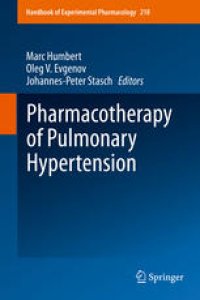
Ebook: Pharmacotherapy of Pulmonary Hypertension
- Tags: Pharmacology/Toxicology, Pharmaceutical Sciences/Technology, Internal Medicine, Pneumology/Respiratory System, Laboratory Medicine, Molecular Medicine
- Series: Handbook of Experimental Pharmacology 218
- Year: 2013
- Publisher: Springer-Verlag Berlin Heidelberg
- Edition: 1
- Language: English
- pdf
This volume focuses on current evidence-based pharmacological treatments of various forms of pulmonary hypertension and provides a comprehensive review of the latest developments in this area. The first part of the book covers the definition, classification, pathophysiology, pathology, biomarkers and animal models of the disease, thus laying the conceptual basis for what follows. The middle section provides an overview of the established therapies, such as calcium channel blockers, prostanoids, endothelin receptor antagonists, phosphodiesterase-5 inhibitors and inhaled nitric oxide. The last section explores novel pathways and emerging therapeutic approaches including soluble guanylate cyclase stimulators, Rho-kinase inhibitors, inhibitors of serotonin receptors and transporters, peptide growth factors, vasoactive peptides, modulators of redox equilibrium and cyclic nucleotide homeostasis, as well as immunosuppressive and anti-proliferative agents. Particular attention is given to the clinical applications of these experimental therapies, that are on the horizon. The book thus spans the continuum from basic science to clinical applications.
Over the past decade, major advancements in the understanding of the molecular mechanisms and pathophysiology of pulmonary hypertension occurred in parallel with the discovery and development of new therapies. Pharmacological agents that modulate the main pathophysiological pathways of pulmonary arterial hypertension have changed the course of this devastating disease by relieving symptoms and improving and prolonging patients’ lives.
The first part of the book covers definition, classification, pathophysiology, pathology, biomarkers and animal models of pulmonary hypertension, thus laying the conceptual basis for what follows. The middle section provides an overview of the established therapies, such as calcium channel blockers, prostanoids, endothelin receptor antagonists, phosphodiesterase-5 inhibitors and inhaled nitric oxide. The concluding section explores novel pathways and emerging therapeutic approaches including soluble guanylate cyclase stimulators, Rho-kinase inhibitors, inhibitors of serotonin receptors and transporters, peptide growth factors, vasoactive peptides, modulators of redox equilibrium and cyclic nucleotides homeostasis, as well as immunosuppressive and anti-proliferative agents. Particular attention is given to clinical applications of these experimental therapies.